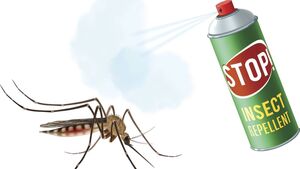A transatlantic tale of midges and mosquitos

Mosquitoes are on the rise in California as the climate changes.
It was a summer decades ago, and my tour-guide colleague, Noel Kelly, was getting to the climax of his performance, having marshalled his troupe of tourists up the boggy mountain behind the Céide Fields Interpretive Centre - his official Office of Public Works narrative becoming increasingly peppered with local folklore, mad stories and his own brand of off-beat humour. Having earlier introduced St Patrick’s legendary visit to the area, Noel now guided his tour group’s attention to the magnificent Dún Bríste sea-stack standing proud in distant ocean off Downpatrick Head.
“And there Crom Dubh, the last pagan druid, made his last stand on that headland, refusing to submit to Patrick - so the saint took out his staff, struck the ground with it and it fell away, leaving Crom stranded on a 365-foot high vertical rock whereupon he was eaten to death by midges...”
Noel waited for the appreciation. For any native, familiar with the small biting flies which swarm in Irish bogs, the humour was delicious. But this particular collection of around 60-odd Americans remained silent, sharing confused glances with one another.
Unfamiliar with this lack of response, Noel leaned in dramatically: “They ate him."
Still nothing. Shrugging his shoulders, Noel decided to continue to the next stopping point - perhaps the story of poteen being made by locals within a 6,000 years old megalithic tomb would garner more interest...
“Excuse me, sir?"
His audience had nominated a leader to comprehend what had just occurred.
Noel turned towards the numerous blank faces.
“How did those little fellers get up there?”
The Ballycastle tour guide’s quizzical look prompted a follow-up explanation from the head of the group.
“I mean, those... um... little people... how did they up onto that rock?”
While Noel remained uncertain, the leader whispered helpfully: “You know…the midgets?"
Caught between wanting to explode into disbelieving laughter and descend into pity for his credulous party who had failed to question any aspect of his myth-making, Noel suggested: “I dunno... ropes I guess”.
It worked, as a murmur of ‘ahh’ and nodded smiles passed around the mountain, while 60 or so elderly Americans accepted the logistics of a swarm of dwarves scaling a vertical cliff-face to cannibalise a stubborn wizard after St Patrick dramatically had changed local geology with his walking stick.
During my first visit to Los Angeles, while Barrack Obama posters promised 'YES - We Can!', I realised that Noel’s group could have been from Southern California, not because Americans here are more credulous than in other states (in fact, probably less so), but due to their unfamiliarity with mosquitos in this desert climate. Also, no woke Californian would even think of mentioning the word ‘midget’ in a sentence.
While Ireland does have mosquitos, the midge is not one of them, being a biting fly. Although for those unfortunates who get bitten, the difference is pretty moot. Biting midges lay their eggs in marginal areas of wetlands, bogs and marshes, later emerging in swarms during humid weather, especially in evenings or overcast days. Mosquitoes, on the other hand, rely on water bodies for their eggs, with type, size and quality of the chosen waterbody determined by the species of mosquito.
California also has mosquitoes, though their numbers were traditionally limited. The state’s dry, Mediterranean-style climate and the relative scarcity of standing water meant they were less of a problem in the past. In recent years, however, warmer temperatures, suburban landscaping that traps moisture and the arrival of invasive species have allowed mosquitoes to spread more widely and remain active for longer.
To combat this, Los Angeles County launched an unusual programme in early summer 2024. Officials released thousands of lab-bred male mosquitoes that had been sterilised through radiation. Because only female mosquitoes bite and reproduce, these sterile males pose no risk to people; instead, they are meant to seek out wild females. When they mate, the resulting eggs fail to hatch, gradually reducing the population. The effort is aimed specifically at Aedes aegypti, a species first detected in the county in 2014 and notorious for its relentless focus on humans.
Scientists point to climate change as a driving factor behind the spread of two invasive mosquito species across California, particularly in the Central Valley and the southern part of the state. These species - Aedes aegypti (the yellow fever mosquito) and Aedes albopictus (the Asian tiger mosquito) - are easy to identify: both are small, dark-coloured and marked with distinctive white stripes along their bodies and legs. Unlike many other mosquitoes, they thrive in close proximity to people, laying eggs in even the tiniest water-filled containers found around homes and gardens.
What makes them especially troublesome is that females bite during the daytime, meaning that even a modest population can quickly become a serious irritation. Beyond being a nuisance, these mosquitoes are also capable of spreading viruses, but so far, dengue is the only one known to have been transmitted locally in California - and even then, very infrequently. Still, it is their persistent, aggressive behaviour that causes the greatest unease among residents.
Unaware of this invasion, the lack of mosquitos was a huge plus for my return to Southern California. I remember sleeping out on the balcony of my landlord’s (the Ethiopian Prince) apartment during the stifling Augusts of Los Angeles of over a decade ago and waking without any non-human bite. Aside from my wife’s preference of a bed and good dental hygiene I would never try that now, especially after chasing mosquitoes around our apartment last year, with sprays, electronic zappers and traps, while taping every external crack shut with gauze and fly screen. I was more prepared this summer and up to the weekend had avoided the painful bites of these alien ‘ankle-biters’. That was to change.
Last Saturday afternoon, a friend and I got lost in conversation over not-a-few drinks in the backyard of his home. As the hours passed I had noticed the odd flying insect but alcohol has a way of both numbing the pain and numbing the brain, so we stayed out chatting as the darkness fell. I took an Uber home and fell to a satisfying sleep on the couch (I had missed my wife’s disturbance deadline).
I awoke to a world of pain, with my body inflamed from literally over one hundred mosquito bites (yes, I counted them). I have suffered from swarms of bites before - from an open hotel window overnight in Odessa during our honeymoon to those becalmed heavy afternoons on a Mayo bog attempting to save turf that didn’t want to be saved. But it was nothing like the swellings erupting on my Irish skin. Even my clothing had not been a barrier to these demons.
Many anti-histamines and soothing creams later, I no longer look (or complain) like a medieval leper. I have also come up with an idea of how to force people to face up to the reality of climate change. If we viscerally felt the results of the destruction of our environment, I think humans would be more receptive to doing something to stop it, more than the use of carbon credits, recycling edicts or environmental guilt trips.
I am not suggesting that each tank of petrol comes with seven mosquitos in your siting room, but as we continue to indulge ourselves in destructive ecological habits, those corporations or agencies contributing the most to climate change should be targeted with cause-and-effect retribution. Why shouldn’t low-lying island communities facing obliteration from rising sea levels get massive compensation from oil companies for decades of CO2 emissions?
And failing that maybe redirect the odd swarm of Crom Dubh-style cannibal midges.





